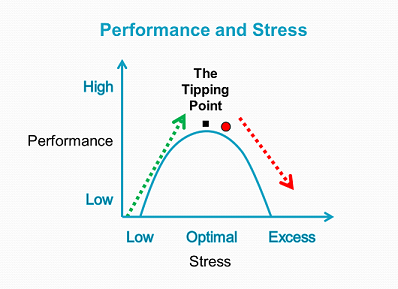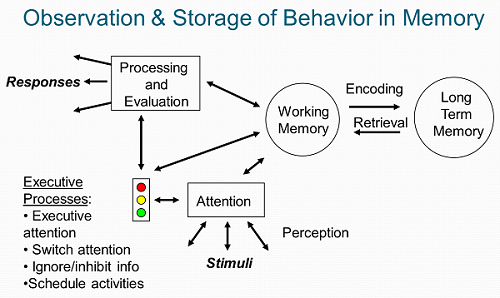When you walk in the room, who shows up for Read more →

The Problem with Your Personal Brand
Allen Slade
When you walk through the door, who shows up for the other people in the room? What image do people have of you? When I walk in, I would like to think that the “real” me shows up. Unfortunately, who actually shows up is an imperfect memory of me. Here’s a picture of the cognitive process of what people remember about you:
Bottom line: The problem with your personal brand is every step of cognition simplifies and distorts the memory of who you are. As Leonardo DiCaprio’s character in the movie Inception says: “But I can’t imagine you with all your complexity, all your perfection, all your imperfection.”
If only a partial image of the “real” you shows up when you walk in the room, you need a brand and a plan. You need a personal brand statement like this:
For [a specific person or group], I want to be known for [six adjectives] so I can deliver [valuable outcomes].
For example, here is part of my own personal brand statement:
For my leadership coaching clients, I bring powerful listening, insightful curiosity and straightforward knowledge to create maximum leadership presence, personal effectiveness and organizational success.
Here are some suggestions on how to craft your own personal brand statement:
Target your brand. You should have a targeted personal brand statement for each group or person you want to impact. For myself, I have three brand statements. You need at least two brand statements.
Be organized. Gather all the data about how others perceive you – performance reviews, personality profiles, 360 feedback, key emails, verbal impressions, etc. Then take at least four hours spread over several days to draft your personal brand statement. Here is a personal brand worksheet to help you get started on defining your own personal brand statement.
Be authentic. Make sure your personal brand is completely compatible with the real you. Being authentic moves your personal brand from false advertising to true marketing. If your personal brand promises what you can actually deliver, you and the people you serve will be happier.
Get feedback. Once you have a draft of your personal brand statement, share it with your circle of trusted advisors. Their reaction to your brand can help you test its authenticity and its value to the people you want to serve. Your circle of trusted advisors should include mentors, spiritual advisors and, ideally, a certified career coach, leadership coach or executive coach.
When you craft a personal brand statement, you help focus the impressions others hold about you. You open doors to new leadership and career opportunities. Then, when you walk in the room, “who shows up” for the other people is the authentically influential you.
What to Expect from Leadership Coaching
Allen Slade
Gifts can be a source of joy or a nasty surprise. If your company provides you a leadership coach, how should you react? Heartfelt delight or muted disappointment? Is leadership coaching the perfect gift for you? Or is it the ugly sweater?
Leadership coaching is a powerful gift when it works as designed. Coaching increases your ability to achieve results and build healthy relationships. It helps you stretch into your best self as a leader.
A talented and wise coach (preferably accredited) will help you stretch into your best self. The coaching conversation can be the high point of your week. Your coach’s insightful listening and powerful questions can trigger new insights into your leadership. The best coaches assume that you are the expert on your own situation. Your coach will draw out your expertise through inquiry, curiosity and gentle challenges. The mini-experiments you design together can lead to breakthroughs in your influence and your presence as a leader.
Leadership coaching comes in different flavors:
Coaching for achievement maximizes your performance in your current role. The leader wants to move from good to great. Your leadership coach will help you focus on the behaviors and thinking necessary to supercharge performance. For achievement coaching to have maximum value, you need to have already learned the ropes. That means 6 months or more in your current job.
Coaching in transition helps you adjust to a new role so you can have a fast start. Your coach will help you learn the ropes – making sense of your new role. Rapid sense-making will help you adjust your behavior, thinking and expectations to accelerate maximum performance in your new role. Transition coaching may start before, during, or soon after the leader has moved into a new role. Sometimes, recruiting firms will provide a leadership coach to ensure that the placement has the greatest odds of success.
Coaching in crisis is designed to turn around an unsuccessful situation. The leader’s performance is unacceptable in one or more ways, and the leader and the organization want to improve the situation. Successful crisis coaching requires the leader, HR and the leader’s manager to agree to have mutual candor, commitment to change and the expectation that things can improve.
When can the gift of coaching turn out to be an ugly sweater? One example is coaching in crisis when the organization has already decided to end the leader’s employment. Another example is when the leader’s confidentiality is violated.
Most ICF accredited coaches take steps to avoid these situations. If no turnaround is possible, Slade & Associates does not offer coaching in crisis. (However, if the leader’s employment is at an end, we gladly offer career coaching as part of outplacement packages.) We always require a written agreement of strict confidentiality. Our approach to leadership coaching safeguards our dialogue, maximizes your insight and drives intelligent change for your organization.

Leadership coaching is an incredible benefit. If your organization offers you a leadership coach, accept the gift gladly. Check on the coach’s credentials. Make sure your coach, your organization and you agree on the purpose of the coaching. Demand coaching confidentiality. Then, prepare to be surprised and delighted as you unwrap the insights and wisdom of leadership coaching.
The Leader’s Tipping Point
By Allen Slade
Leadership is about creating sustainable performance in your team. Jim Clawson points out that effective leadership is “managing energy, first in yourself, then in those around you.” In a post on The Tipping Point of Performance, I talked about managing energy in others to create sustainable performance. As a leader, you have a proven track record of results. You combine competence, capacity and committent to success, so people are willing to follow you. But is your performance sustainable?
Bottom line: As a leader, you have to manage your own energy. Know your performance curve, watch for signs of an impending performance crisis and take dramatic action as needed.
The performance curve is just as true for you as it is for the people you lead. We all experience this inverted-U relationship between stress and performance. A straight line relationship between your level of stress and your performance holds, but only in the green zone.
 If you are in your own green zone, you adjust your effort level to the demands of the situation. Stress triggers higher performance. If you face higher demands, you stay longer, work harder, decide faster. All is well until you reach your tipping point. Then, more stress equals less performance. Further pressure for performance, from yourself or from external demands, drives you into the red zone. You become the red marble accelerating down the performance curve. As a leader, a stress-induced performance crisis not only hurts your productivity, it can undermine your credibility as a leader.
If you are in your own green zone, you adjust your effort level to the demands of the situation. Stress triggers higher performance. If you face higher demands, you stay longer, work harder, decide faster. All is well until you reach your tipping point. Then, more stress equals less performance. Further pressure for performance, from yourself or from external demands, drives you into the red zone. You become the red marble accelerating down the performance curve. As a leader, a stress-induced performance crisis not only hurts your productivity, it can undermine your credibility as a leader.
Bottom line: Push youself, but know your own tipping point. As Bob Rosen says, lead with just enough anxiety.
Manage your own stress wisely, especially on the dangerous part of the performance curve.
Stress reduction strategies. Whether you are at the top of the green zone or at the tipping point, try stress management strategies. Simplify your life. Practice centering. Off load non-essential work. Get help from your boss, in terms of more people, more resources or more time. Ask your colleagues for support. Delegate to your team.
Develop yourself. Long-term, grow your capacity for performance to avoid a stress-induced performance crisis. Develop new skills. Practice skills to the point of mastery. Practice for speed, not just completion. If you can write methodically, practice writing under a deadline. (Blogging three times a week is speeding up my writing!) Coaching can help, whether you are an executive, leader or golfer. At Slade & Associates, we coach executives and leaders to maximize their performance. There are certain things we don’t do, so you would do well to find your own golf coach.
Your urgency in reducing your stress depends on your position on the performance curve:
Top of the green zone. If you push harder but don’t see much improvement, you may be approaching the top of your green zone. Be careful, because you could hit your tipping point. Be alert for further stress, and consider strategies to reduce stressors or increase your performance capacity.
The tipping point. Approaching your tipping zone is dangerous. If familiar tasks become harder, if your inbox is overwhelming, if you snap at reasonable requests or if you work longer with fewer results, you may be at your tipping point. At the tipping point, you still have time. You can think. You can experiment with one stress reducer at a time. Take action now to reduce your stress. Climb back down into the green zone while you can still think clearly.
The red zone. Passing your tipping point is catastrophic because of the accelerating downward spiral of performance. To get out of the red zone, aggressively implement stress management strategies. Make a plan that combines at least two or three big stress reducers – simplify, center, get support from your boss, delegate, etc. Make smart requests ask your boss for support or delegate. Whatever the details, take dramatic action. In the red zone, you must act now.
A lifeguard. I must confess: This red zone advice may not work. The downward spiral of performance undermines your decision making and behavioral flexibility. If you are drowning, sometimes you can’t save yourself. You need a lifeguard who will know you need help and step in during a crisis. Your lifeguard could be a friend, a mentor, a coach or your family. Before a red zone crisis, build strong relationships. Be transparent, accountable and open to constructive feedback. Then, if you are drowning in stress, you will have someone willing to dive in to save you.
Being mindful of the performance curve can help maximize sustainable performance for yourself and for the people you lead. So go lead with just enough anxiety.
The Tipping Point of Performance
Allen Slade
I love sports movies, especially about underdogs. The critical moment is when the coach or loved one gets the underdog fired up. I love Rocky II, when Talia Shire lights Rocky’s fuse from her hospital bed and Remember the Titans, when Denzel Washington gives a moving call for unity in the Gettysburg cemetery.
As a leader, do you try to fire up your team? Be careful. If you play with fire, you can get burned.
Clearly, there are times when you need to establish a sense of urgency. But asking for extraordinary effort can backfire. As the performance curve below shows, there is an inverted-U relationship between stress and performance. A straight line relationship between stress and performance does hold, but only in the green zone.
 A leader who operates in the green zone can increase performance with stress. A complacent team may benefit from getting fired up. Stress triggers higher performance. The leadership situation has to be right: sufficient trust, basic equity and the capability to perform better. Given those things, adding some stress adds some performance. More stress creates more performance. This straight line relationship is a simple recipe for success: up the quota, accelerate the deadline, give the locker room speech or crack the whip and the underdog becomes the champ.
A leader who operates in the green zone can increase performance with stress. A complacent team may benefit from getting fired up. Stress triggers higher performance. The leadership situation has to be right: sufficient trust, basic equity and the capability to perform better. Given those things, adding some stress adds some performance. More stress creates more performance. This straight line relationship is a simple recipe for success: up the quota, accelerate the deadline, give the locker room speech or crack the whip and the underdog becomes the champ.
The problem hits at the top of the curve. When a person reaches the tipping point, more stress equals less performance. Further pressure for performance leads to a downward spiral in the red zone. People become anxious. They act indecisively, work slower or make more mistakes. As their performance decreases, their anxiety increases, further decreasing their performance. Notice the red marble at the top of the performance curve. In the red zone, the marble accelerates down the curve of poor performance. As a leader, if you push a person too far, their performance drops. And, their performance will continue to get worse because of the downward spiral.
Bottom line: Push for performance, but avoid the tipping point for stress. As Bob Rosen says, lead with just enough anxiety.
Aim for high performance, not peak performance. I coach leaders to avoid pushing people to their tipping point. If the tipping point is at 100% performance, aim for 90 or 95%. Then, your team member has a stress buffer. If there is a coffee spill that wipes critical data or a car wreck going to the big meeting, they will have the psychological reserves to get through it. If you push to get the full 100%, your people may tip into the red zone.
Develop your people. If you wish to increase performance, but a person is near the tipping point, think development first, motivation later. Increase their competence and capacity, so they can perform better while maintaining an essential stress buffer.
Be a lifeguard. Your people can drown in stress. The downward spiral of performance undermines decision making and behavioral flexibility. If someone is in the red zone, you may need be their lifeguard. Watch for signs of stress in your team members, watching for people at the tipping point or in the red zone. Then, throw them a life line. Offer more resources, renegotiate deadlines, offer them time off to refresh and rest. Be creative – think of the rousing speech that fires up the underdog, then do the opposite.
Know your team. Everyone is different. The people you lead have different capabilities and stress tolerances. They will show different warning signs of a stress-induced performance crisis. Get to know your people before a crisis. Have regular dialogue with every team member. Seek insight about their performance patterns, personal stressors and individual signs of overload. This will equip you to be a stress lifeguard.
Being mindful of the performance curve can help maximize sustainable performance for the people you lead. So go lead with just enough anxiety.

